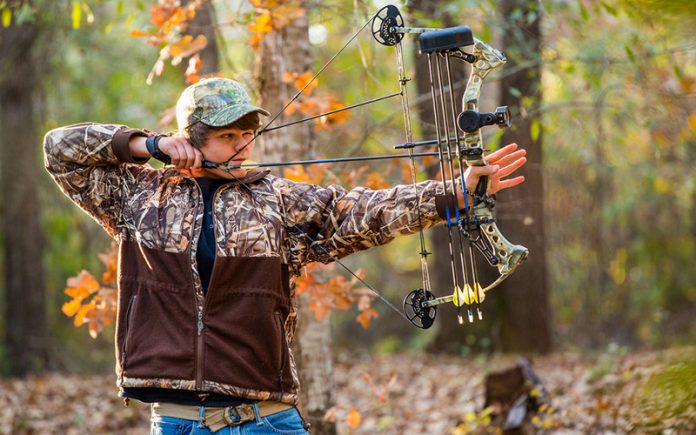Archery is incredibly fun and an essential survival skill, as depicted in numerous movie franchises and TV series. Whether your role model is Katniss Everdeen or the Green Arrow, whenever you watch them, you feel like picking up a bow and shooting arrows like them too. And when you eventually manage to hit the bullseye for the first time, that feeling seems indescribably good to you.
I remember when I first scored a bullseye and shared the joy with all of my buddies. Although it doesn’t take much to hit the bullseye at 10 meters, 20 meters or even 30 meters away, it does take a good deal of patience, willpower and determination to reduce the shot grouping. This means all of your shots will land closer to each other, resulting in more precise shots. Mastering the art of archery is a challenge on its own, but to get you going, we have provided a guide on how to use a compound bow and other aspects of compound bow for beginners.
Compound Bow for Beginners: What Makes Compound Bows Suitable for Beginners?
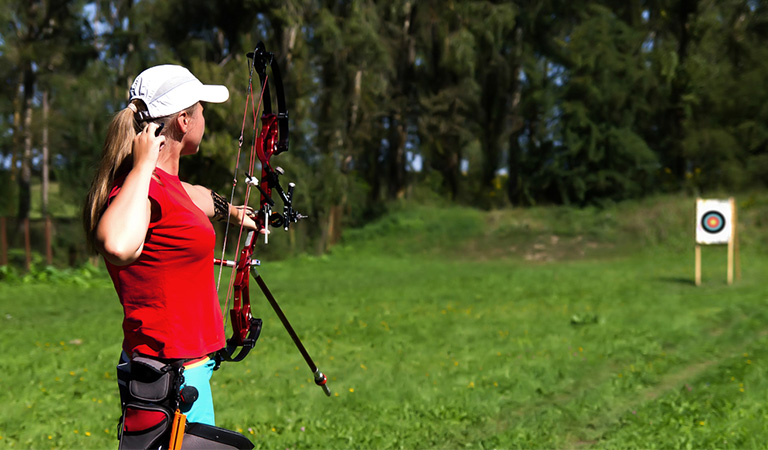
Bows and arrows have been used throughout human history as hunting and war equipment. Although the use of bows and arrows are now strictly limited to recreational and hunting events, the principles are basically the same. Compound bows are fairly modern versions of the bow design and are deemed to be perfect for beginners. Believe us, there are good reasons for that.
- Compound bows are stiffer and more rigid, making them more energy-efficient in terms of limb movement.
- Compound bows usually have longer strings, but it depends on the type you buy. For example, children’s compound bows have shorter strings, which means you can pull back further and produce more power. As a result, you get greater stability and accuracy along with power.
- Due to the pulley system, you get to apply a consistent level of force with every arrow that you shoot, thus shooting with enough accuracy each time. Thus, it’s the perfect bow not only for archery practice but for hunting as well.
- The beginner archers usually choose soft cam to allow the arrow to accelerate in a gentle manner. The pulleys and cams control arrow acceleration. With the cams in place, you will require a lesser amount of energy to retain your aim in the firing position.
- When you draw a compound bow, the limbs pull in towards each other rather than towards the direction of the string being pulled, unlike other bows. The slight difference in position reduces vibration and chances of recoil of the shooter, which is best for beginners who may get startled after experiencing recoil.
- You can add dampeners and stabilizers for a more steady hold when drawing the bow, which would reduce the arrow movement as it’s released. This also reduces the recoil shock felt by the shooter, on the elbows and shoulders.
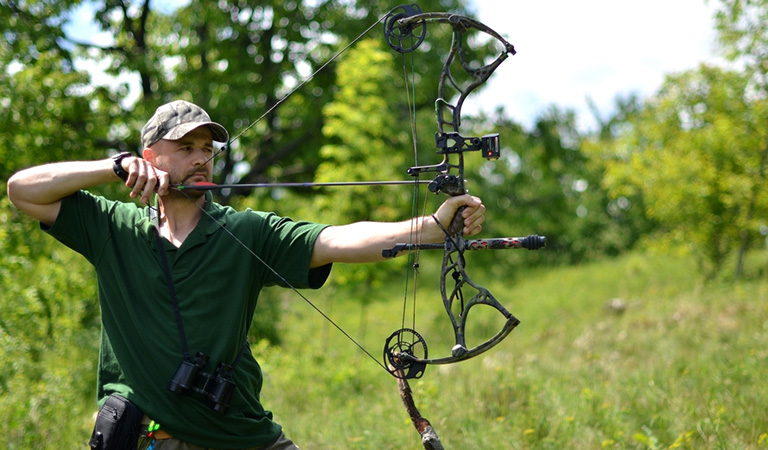
Compound bows do have a few setbacks. You have to buy additional parts which also require additional maintenance. Replacing strings or adjustments is also a hassle as you would need to go to archery shops to get them fixed. So, before buying a compound bow you should consider your budget. Other than that, compound bows are better for practice compared to recurve bows, as you can get a hand of archery better. So, compound bow for beginners would help them compensate for the lack of experience better than other bows that solely depend upon muscle memory to shoot.
How to Shoot a Compound Bow?
Beginners may have difficulty taking the proper stance and firing properly, so here’s a step by step guide on how to hold the bow, take a position and fire it properly.
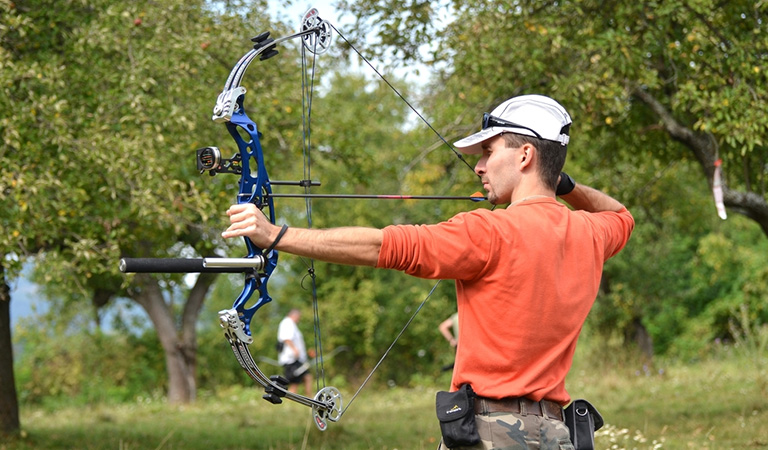
- Observe your target. If you are right-handed (usually left eye dominant), make sure your left side is facing the target. Keep your right foot slightly behind the shooting line. Toes don’t have to face the target, just position them comfortably. Overall, your position should be at right angles to the target.
- Grip the compound bow in such a way that the bow weight is evenly distributed across the center of your palm. Don’t pull the bow too far back or too far forward, which means don’t depend on your finger strength or the wrist strength too much. Just focus on the grip. Don’t grip too tightly, as this could twist the bow when you fire your compound bow arrows.
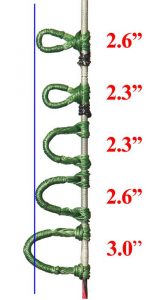
D-Loop - Snap an arrow into the notch and pull it back into the string. It will click into place through the nocking point, also called the D-loop. Attach a mechanical release to the part where the arrow is attached. You don’t need to attach mechanical release if you want to fire an arrow with your fingers. Attach the mechanical release to the wrist and close its jaws around the loop. Attachments like these are what make compound bow easy and more comfortable for beginners.
- You need to stand strong and still for accurate shooting. Keep eyes on the target and don’t move much; otherwise, you can shoot an arrow off-target.
- Determine arrow distance. Different bows have various distances. These are adjustable, so it’s better to check the compound bow manual in this regard.
- Hold the bow up and maintain the grip. Slightly bend your elbow for extra comfort so that when the arrow shoots away, your arm won’t twitch in recoil.
- Time to draw the bow back. Pull it in a smooth solid motion, ensuring that your other arm is straight and aimed towards the target. Use this straight arm as a guide to make the pull as straight as possible. For more power, you can rotate your shoulder a bit backward without actually moving your whole body. When drawing back, don’t move the bow or point it anywhere other than the target.
- Now determine an anchor point for yourself. This is the point where the bow will be drawn fully against your cheek. This is a personal spot, so it could be near your ear too. This anchor point is common for every time you shoot an arrow, so it must be at a place where you feel comfortable.
- You’ll need to fix another anchor point which would be the tip of your nose. Keep the nose as close to the string as possible. This would increase the accuracy. Don’t bend your neck to align the nose with your bow.
- Release the trigger by lowering your finger slowly; don’t end up pulling the release trigger. Allow your finger to pull back the trigger and release the arrow. If you’re not using a mechanical release, then just let go of the fingers after pulling back and get them out of the way with release. There will be a release of force that may cause you to recoil and jerk back. Make sure to keep your body still.
And friends, that’s how you shoot a compound bow! If this doesn’t help, it’s better to take archery lessons and watch YouTube tutorials for better understanding.
Here are a few facts that you need to know to ensure getting archery right. First of all, relax. Don’t tense up your muscles; otherwise, it could affect your accuracy. Just aim and release quick. I want to stress out again on not to move the bow or yourself because that would mean re-aiming over and over again.
The draw weight depends on the age, but most beginners start with 10 lbs. With this draw weight, you won’t have to pull too farther away or use too much power to draw back the same amount. Over time, you’ll see that your arrows are firing closer and closer to the target. That’s good news. This is better for the compound bow for beginners and pros. However, the real happiness comes when you reach the point where you hit the target every single time. So keep practicing!


